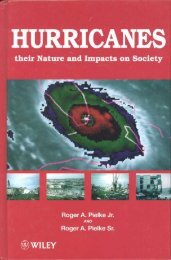A Preliminary Study of the Burgers Equation with Symbolic ...
A Preliminary Study of the Burgers Equation with Symbolic ...
A Preliminary Study of the Burgers Equation with Symbolic ...
Create successful ePaper yourself
Turn your PDF publications into a flip-book with our unique Google optimized e-Paper software.
242 DERICKSON AND PIELKE, SR.<br />
and<br />
Llarge = L1L2<br />
, (A7)<br />
L1 − L2<br />
where it is emphasized that <strong>the</strong> smaller (larger) wavelength is associated <strong>with</strong> <strong>the</strong> larger<br />
(smaller) wavenumber. The process leading to <strong>the</strong> creation <strong>of</strong> smaller waves is referred to<br />
as outscatter. Similarly, <strong>the</strong> creation <strong>of</strong> larger waves from <strong>the</strong> nonlinear interaction between<br />
smaller waves is termed backscatter. The two nonlinear mechanisms constitute <strong>the</strong> inertial<br />
transfer <strong>of</strong> momentum between scales. In general, outscatter can be thought <strong>of</strong> as a production<br />
mechanism and backscatter as a modification to existing lower harmonics. However,<br />
because both processes constitute <strong>the</strong> inertial transfer <strong>of</strong> momentum (and energy) between<br />
scales, nei<strong>the</strong>r outscatter nor backscatter add to or subtract momentum (or energy) from <strong>the</strong><br />
system. Thus, use <strong>of</strong> <strong>the</strong> word production here only refers to <strong>the</strong> creation <strong>of</strong> higher order<br />
harmonics at <strong>the</strong> expense <strong>of</strong> lower order ones. Actual production to a system is through<br />
large-scale shear or buoyancy, which are excluded in <strong>the</strong> current study.<br />
Beyond <strong>the</strong> initial interaction <strong>of</strong> two waves in a time varying nonlinear process, <strong>the</strong> “birth”<br />
<strong>of</strong> new waves creates a large, increasing number <strong>of</strong> nonlinear interactions as time evolves.<br />
<strong>Symbolic</strong> computation provides an effective tool to explore <strong>the</strong> intricacies <strong>of</strong> such a large<br />
number <strong>of</strong> nonlinear interactions in a study <strong>of</strong> developing 1-D “burgulence.”<br />
APPENDIX B: ISOLATING OUTSCATTER, BACKSCATTER, AND VISCOUS DAMPING<br />
In this appendix, a method is developed to isolate and integrate <strong>the</strong> individual effects <strong>of</strong><br />
outscatter, backscatter, and viscous damping at each discrete time step in <strong>the</strong> symbolic solution<br />
<strong>of</strong> <strong>Burgers</strong> equation. The method is applied to <strong>the</strong> solution in a post-processing fashion.<br />
The solution at each discrete time level can be expressed as<br />
u(x, mt) = F1 sin(κx) + F2 sin(2κx) + F3 sin(3κx) +···+ FN sin(Nκx), (B1)<br />
in which all terms associated <strong>with</strong> <strong>the</strong> amplitude <strong>of</strong> each respective harmonic are lumped<br />
into <strong>the</strong> symbols F1, F2, F3, etc., ra<strong>the</strong>r than kept in expanded form. <strong>Symbolic</strong> integration<br />
to <strong>the</strong> next time level is achieved by substituting (B1) into <strong>the</strong> forward-in-time algorithm,<br />
(7a), to yield<br />
⎧<br />
⎫<br />
u(x,(m+1)t)=u(x, mt)+κt<br />
N<br />
n=1<br />
n<br />
2<br />
−<br />
⎪⎨<br />
⎪⎩<br />
outscatter<br />
L<br />
p<br />
l=1 Fl F|l−n| − 1<br />
2 F 2 n/2<br />
+<br />
backscatter<br />
Lb<br />
l=1 Fl Fl+n<br />
viscous damping<br />
− 2n κ<br />
Re Fn<br />
<br />
<br />
<br />
⎪⎬<br />
sin(nκx),<br />
(B2)<br />
in which n = 1, 2, 3,...,N corresponds to <strong>the</strong> individual harmonics, and <strong>the</strong> subscript<br />
l = 1, 2, 3,...,Lpor Lb represents <strong>the</strong> amplitude pairs involved in outscatter or backscatter<br />
for each harmonic <strong>of</strong> <strong>the</strong> solution. In general L p = Lb, and L p and Lb differ from one<br />
harmonic to <strong>the</strong> next. The outscatter, backscatter, and damping terms have been identified<br />
is applied only to production by outscatter <strong>of</strong> odd harmonics<br />
in (B2). The term 1<br />
2 F 2 n/2<br />
⎪⎭














